
(Updated at 11:55 a.m.) This week, Fairfax City kicked off a project to build a new 530-foot sidewalk on Chain Bridge Road’s east side, connecting Old Town Fairfax with the Northfax areas.
On Monday (Feb. 5), construction crews began work on the new eastern sidewalk from Jenny Lynne Lane to Kenmore Drive, with plans also to relocate a pedestrian crossing at Cedar Avenue from the south to the north side to make pedestrians more visible to motorists..
Slated for completion in July, roadwork is scheduled from 9:30 a.m. to 3 p.m. during the week, with reduced hours on Friday. Off-road construction will occur from 7 a.m. to 6 p.m., Monday to Friday, avoiding weekends.
The east Chain Bridge Road sidewalk improvement project was approved in 2021 and was paid for using a total of $430,000 in federal and local funds.
A public hearing is planned for summer 2024 to discuss allocating another $9.25 million for additional improvements along the western edge of Chain Bridge Road, which extends from Taba Cove to Warwick Avenue.
In 2020, the city applied for SmartScale funding, which is allocated by the state for transportation projects, for this initiative.
The improvements along the west side of Chain Bridge Road would include improvements to pedestrian crossings at five intersections, upgrades to two bus stops, a new drainage system, new street lighting, and the construction of a retaining wall.
Image via Google Maps
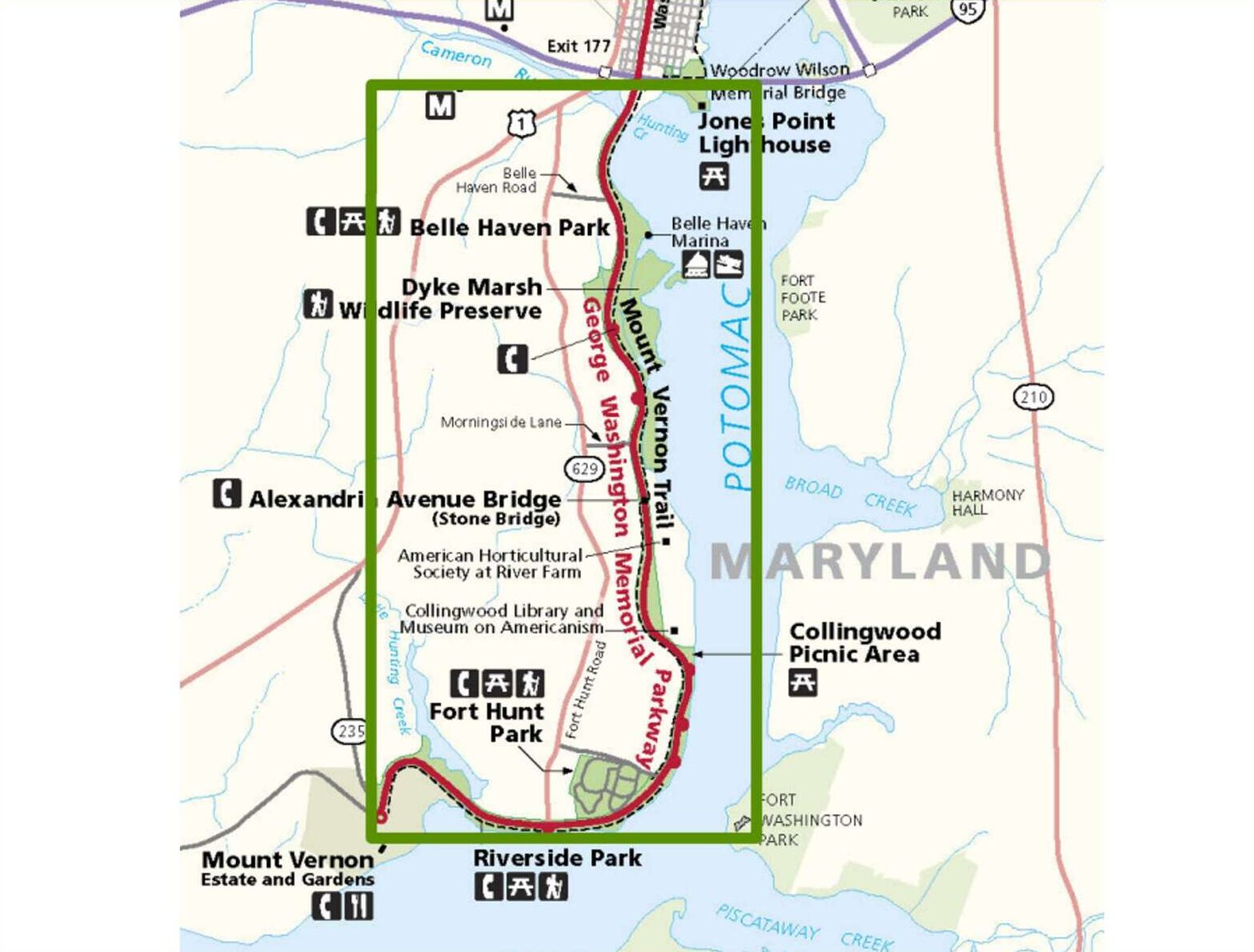
A stretch of the George Washington Memorial Parkway in southern Fairfax County is moving toward some major changes, as is the neighboring Mount Vernon Trail.
The National Park Service, which maintains the GW Parkway and much of the Mount Vernon Trail, plans to start “initial design work and planning for key aspects of the project” this year, per a Jan. 26 press release.
The announcement came after the Environmental Protection Agency released an assessment finding no significant environmental effects from the proposed changes, which will include a road diet and intersection and trail upgrades.
Once work is done, the parkway will be reduced to one southbound travel lane between Mount Vernon and Belle View Boulevard and one northbound lane between Mount Vernon and Tulane Drive. The Mount Vernon Trail, which is typically 8 or 9 feet wide right now, will be expanded to 10 or 12 feet wide in certain areas.
“The primary goal of the project is to enhance safety and reliability for users of the parkway and trail, while preserving the area’s scenic and historic character,” the NPS said. “As vital routes for both local and visiting cyclists, pedestrians, and drivers, these improvements are crucial for the continued enjoyment and safety of everyone who uses these routes.”
The affected portion of the GW Parkway covers about 8.5 miles from George Washington’s Mount Vernon estate (3200 Mount Vernon Memorial Highway) up to the Hunting Creek Bridge south of Alexandria City. According to the NPS, neither the south section of the Parkway nor its drainage systems has had a “comprehensive rehabilitation” since it was constructed in 1932.
Other changes will include a replacement of road surface that the NPS characterizes as “deteriorated” and improvements to drainage and stormwater management.
On the portion of the roadway with a road diet, the plan is to set up two right-hand shoulders or, at southbound intersections, right-turn lanes. Plus, the road will feature a new striped median or center turn lane.
A number of intersections will also see updates intended to make them safer, including the ones with Vernon View Drive, Waynewood Blvd and the access to Tulane Drive, Belle View Blvd and Morningside Lane. A study of crashes on GW Parkway in 2005-2015 and 2018-2019 revealed crashes were most severe at intersections with those roadways, mostly due to vehicle speeds.
Select intersections will also get crosswalks.
The NPS-administered portions of the Mount Vernon Trail will also see stormwater management improvements. Four trail bridges will be replaced, and repairs are planned for 29 more.
The planned trail widening comes nearly four years after NPS finished a study that determined the trail is “relatively narrow by modern standards.”
A full construction schedule and traffic management plan will come after initial design work and planning, but NPS documents indicate that the trail will remain usable to pedestrians and cyclists during construction. Closed sections will be serviced by alternate routes and temporary detours.
The affected section of the GW Parkway may see temporary lane closures, and access to its “recreational, natural, and cultural areas” may be restricted during construction, per the environmental assessment for the project.
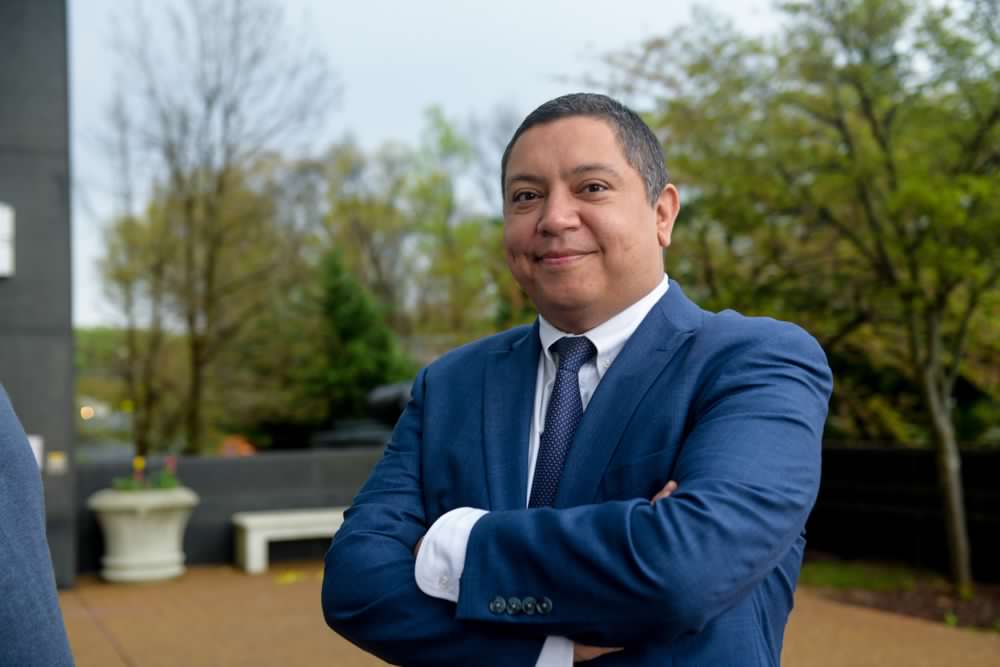
For the first time this century, Fairfax County’s Mason District has a new supervisor.
In his first week since succeeding Penny Gross, who retired in December after 27 years in the position, Andres Jimenez says he has been actively engaging with constituents to tackle issues ranging from transportation to art projects and economic development.
An immigrant from Bogota, Colombia, who has now lived in the Falls Church area for 12 years, Jimenez is the first Latino to represent Mason District on the Fairfax County Board of Supervisors. He also works as the executive director of the pay equity campaign Green 2.0 and previously served as an at-large member of the Fairfax County Planning Commission.
Winning a decisive victory last November over independent candidate Terry Modglin with 72% of the vote, Jimenez says that, since taking office on Jan. 1, he has been setting up his various social media channels, launching a new podcast and organizing several public forums across the district.
“I think that smart government is when residents don’t just come to you, it’s when the government — when the supervisor’s office — is going into the community and reaching out to residents…and asking them what is working, what’s not working, because only then can you really begin to make change,” he told FFXnow.
The dates for the public town hall and open house events have not been announced yet. However, Jimenez anticipates key areas will include transportation, housing and economic development.
“We do plan to go out into the communities [and] listen to the residents and make sure that we are prioritizing the needs of Mason District,” he said.
Pedestrian and traffic safety
Top on Jimenez’s agenda is addressing pedestrian and traffic safety concerns in neighborhoods like Annandale, Bailey’s Crossroads and Seven Corners.
Last year, the community advocacy group Fairfax Families for Safe Streets published a report showing that pedestrian fatalities increased in 2022 as a result of “underfunding for pedestrian-focused projects.”
“Unfortunately, there have been a lot of fatalities when it comes to the pedestrians,” Jimenez said. “…We need to really start working on figuring out not only why is this happening, but how can we solve this problem.”
In 2021, the Board of Supervisors approved $100 million for county-wide pedestrian and bicycle infrastructure improvements that will be allocated to different projects through 2028. About $30.2 million has been allocated to date, according to the county website.
At the moment, the county is reviewing 69 proposed safety projects proposed for Mason District. Each of the projects originated from resident suggestions through a county-led online survey.
Jimenez emphasized his objective is to ensure that money is promptly allocated to projects in Mason District, adding that the money is “desperately needed.”
Jimenez identified a few intersections — such as Leesburg Pike (Route 7) at both Row Street and Columbia Pike — as high priority, focusing more on signal upgrades and other spot improvements than more comprehensive, long-term solutions.
In the coming months, Jimenez noted that he plans to consult with local stakeholder groups, such as the Bailey’s Crossroads 7 Corners Revitalization Corporation, to help identify projects that need immediate attention.
“We’ve already identified several initiatives — obviously Seven Corners, Bailey’s Crossroads and Annandale — that need help,” he said. “They need signage and they need timers and they need different ways to make sure that pedestrians are safe.”
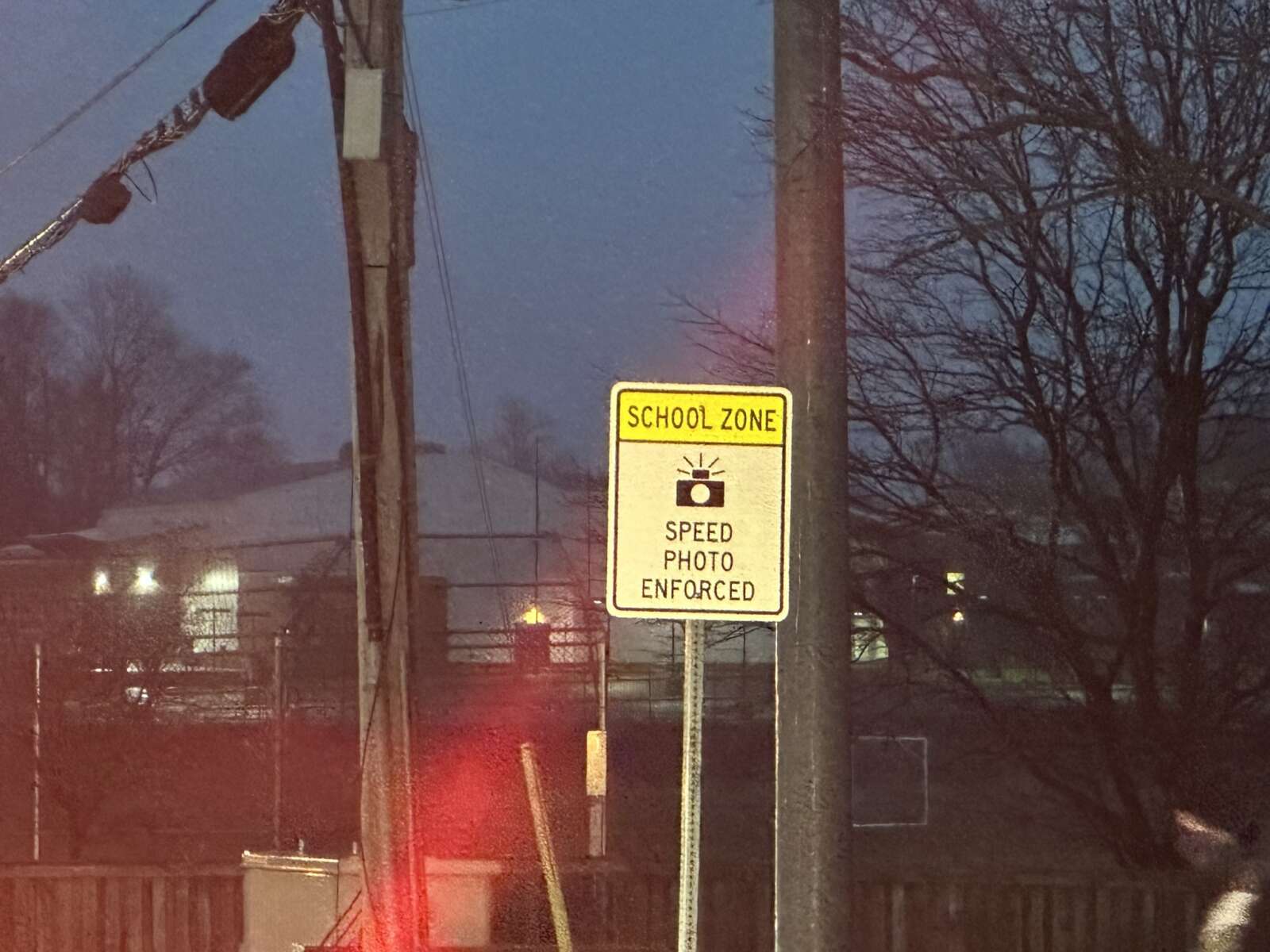
When they reconvene this month, Virginia lawmakers will consider a proposal to allow local governments to install speed cameras wherever they deem them necessary, with penalties of up to $100 for violations.
Bill patron Del.-elect Mike Jones, D-Richmond, said the legislation is intended to increase speed enforcement and reduce the number of traffic fatalities.
“It gives localities the decision of whether they want to do it or not,” said Jones. “So it’s not a ‘shall’ — every locality will have it — but for the ones that are concerned with this, it would help them out.”
State law currently allows local governments to install speed cameras in work and school zones as a way to drivers to go slower around children and construction workers. Jones’ bill would go further, allowing their placement in “any location deemed necessary” by local governments.
However, the use of more cameras to enforce speed laws has previously sparked controversy over privacy and public perceptions that the technology is just another way for a locality to raise revenue.
In November, amid a Frederick County debate, outgoing Supervisor Shawn Graber told the Mercury that “there should never be a time when a locality tries to simply put something in effect to make money from someone else’s misdoing.”
Jones said he understands the concerns, but argued people are asking for safer streets and safer neighborhoods.
“There’s not enough police for them and/or they don’t respond to neighborhoods simply because of numbers,” said Jones. “I understand the concern for the overpolicing, I get that. I get that as an African American male, I get that as pastor of an African American church, a Black legislator that represented predominantly Black and brown people. I hear that, but the reality is this: People aren’t dying in a lot of these different neighborhoods; where they’re literally dying is in mine.”
Virginia Department of Motor Vehicles data found that last year, 20% of the 122,434 crashes in the state were speed related, a 1% increase over the previous year. Virginia Department of Transportation crash data also shows that between 2018 and 2022, the annual number of traffic fatalities increased from 819 to 1,005.
The DMV said that on average, 2.8 lives are lost and 163 people injured every day because of traffic crashes.
Rob Billington, a spokesman for the Virginia Municipal League, which represents city and town governments in the commonwealth, said the league supports letting local governments expand the use of speed cameras on all roads at all times. He said traditionally VML has supported local flexibility, and it sees Jones’ bill as providing that. Read More
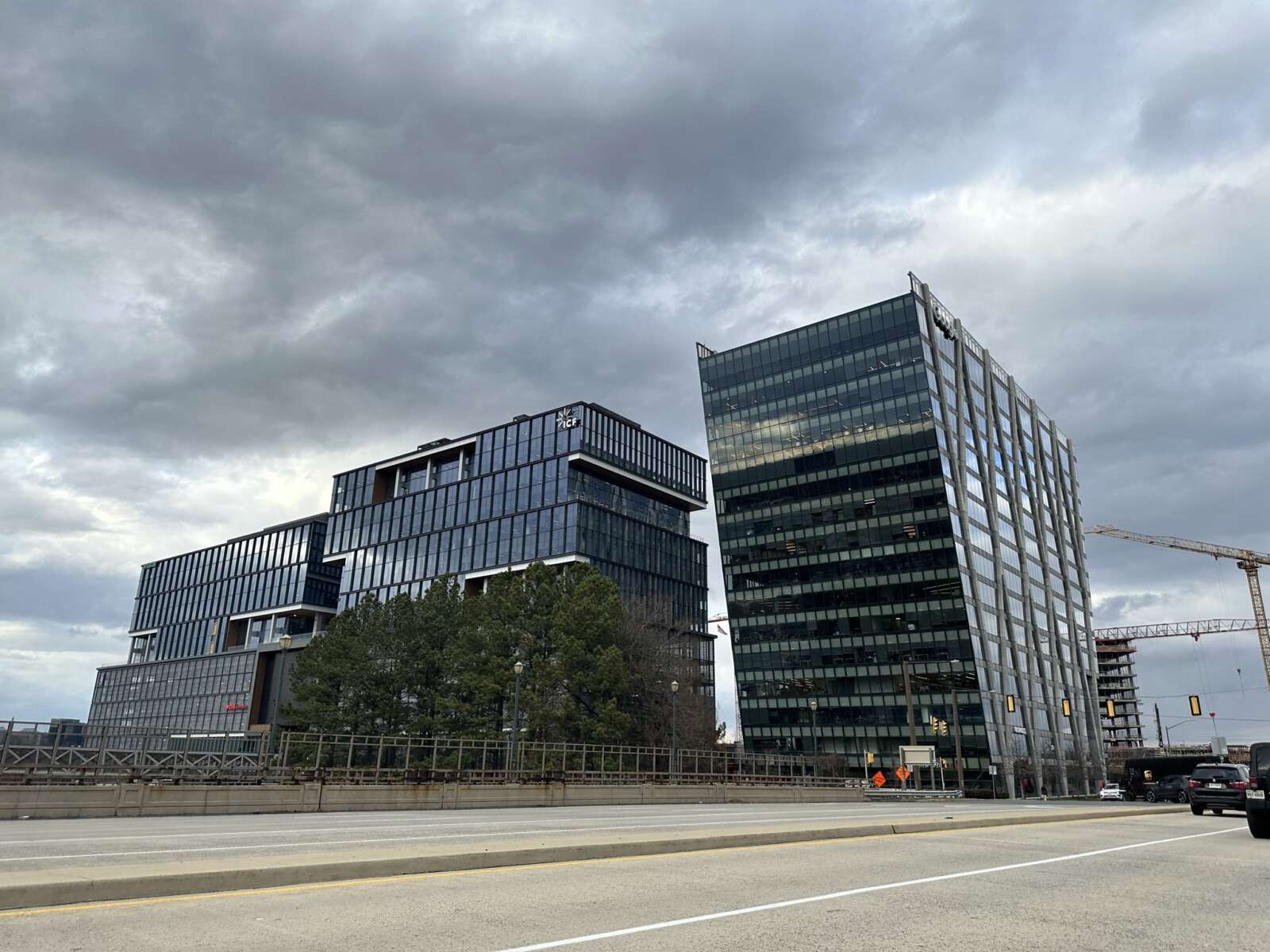
Updated at 8:40 p.m. on 11/8/2023 — The community workshop has been relocated to the cafeteria of Langston Hughes Middle School (11401 Ridge Heights Road).
Earlier: Fairfax County is formally launching a new study on how to shift Wiehle Avenue from a car-dominated, suburban road to a multimodal, urban street.
The Wiehle Avenue study kicks off with an in-person community workshop on Nov. 13.
After diving into the background and purpose of the study, the county will open the floor for attendees to brainstorm ideas on how to improve the road between Sunrise Valley Drive and the Washington & Old Dominion Trail in Reston.
The ideas proposed by the community will later be refined into three concepts “to test in future (year 2030) scenarios” by the Fairfax County Department of Transporation and its consultant, Fehr & Peers, FCDOT spokesperson Freddy Serrano says.
“[The scenarios] will give us an overview of how potential changes may affect traffic operations and accessibility and comfort for pedestrians, bicyclists, and transit users,” Serrano told FFXnow. “We will take these concepts and the resulting future analysis back to the public early next year and will solicit their feedback to arrive at a preferred concept for Wiehle Avenue.”
The Fairfax County Board of Supervisors initiated the Wiehle Avenue study as a follow-on motion after approving TF Cornerstone’s Campus Commons redevelopment plan in 2019.
The project prompted vigorous debate on the safety of a proposed pedestrian crossing at the intersection Dulles Toll Road ramps and Wiehle Avenue. An alternative is being explored after the developer offered $1.65 million instead of developing a solution.
The county previously convened a study group to evaluate options for that crossing, but the group didn’t support any of the developer’s proposals.
FCDOT says this new study will take a broader look at the corridor and how it may have been affected by the opening of Metro’s Silver Line extension last year.
“This effort is expected to identify new and improved bicycle/pedestrian facilities and intersection treatments, as well as evaluate the potential reconfiguration of vehicular lanes and/or widths for current and future land use scenarios,” the department said in a news release.
The community meeting takes place from 5:30-9 p.m. in the second floor conference room of 1900 Reston Metro Plaza. A light dinner will be provided. RSVPs are encouraged through an online feedback form.
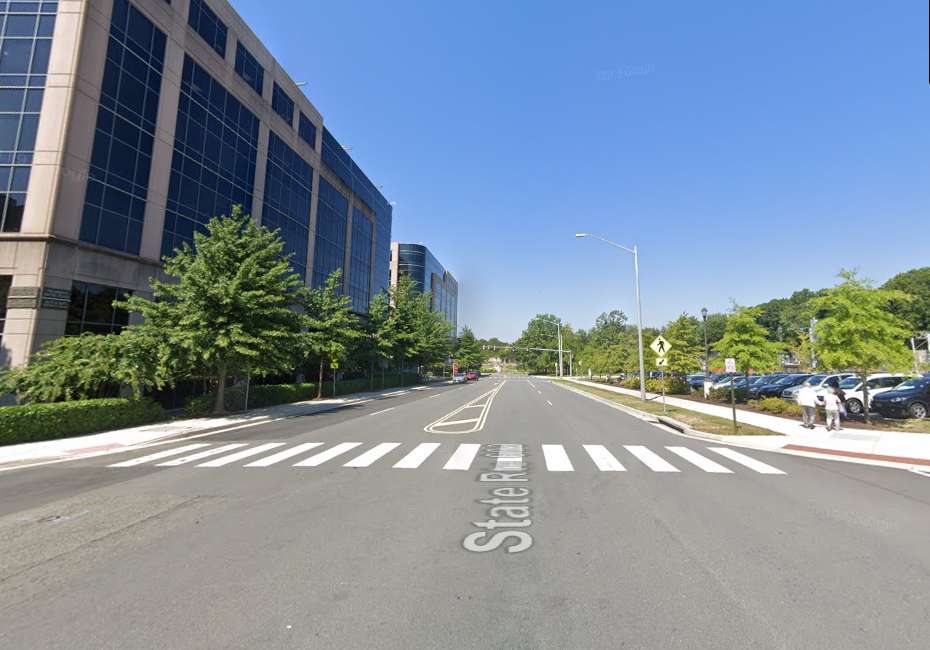
Fairfax County is designing a new layout for Prosperity Avenue near the Dunn Loring Metro station.
The new configuration will reduce the roadway from four to two lanes by adding a road diet and protected bicycle lanes between Gallows Road and Prosperity Metro Plaza, the two-building office center whose tenants include U.S. Customs and Immigration Services’ D.C. field office.
The project will also convert existing on-street bicycle lanes that start to the west and continue until Hilltop Road into protected bike lanes.
Design funding will come from the Metropolitan Washington Council of Governments (COG), whose Transportation Planning Board awarded $80,000 to the project last week as part of its Transit Within Reach program.
COG is “excited” about the county’s proposed improvements to Prosperity Avenue, which currently has a “very wide” design that “encourages drivers to speed and discourages people from walking and biking,” according to John Swanson, the principal transportation planner for the regional nonprofit.
The affected section of Prosperity Avenue has a 35 mph speed limit. A 19-year-old man from Chantilly was killed in a crash on the road last December, but that occurred to the south between Route 29 and Arlington Blvd.
“This part of Fairfax is undergoing a lot of change and the county is really committed to making the Dunn Loring station the center of a vibrant, walkable community,” Swanson said. “…This kind of project will make a real difference at the local level and will serve as a model for the region.”
The idea for the Prosperity Avenue safety project emerged out of discussions that started in April between representatives of businesses along the roadway and Providence District Supervisor Dalia Palchik’s office.
Since then, the district office has been working with county and state transportation staff to develop their proposal.
“I am delighted to see that this project design was approved for funding!” Palchik said in a statement. “After hearing from local businesses about safety concerns for their staff and visitors, my office worked diligently with FCDOT and VDOT on a proposal for a road diet for Prosperity Avenue. This design work will help improve safety for our pedestrians, especially for staff and community members visiting the USCIS offices or attending naturalization ceremonies.”
The Transit Within Reach funds will cover the project design up to 30% completion, according to the Fairfax County Department of Transportation. That will encompass the bicycle lanes from west of the Metro station to Hilltop Avenue, which is expected to be completed around the end of 2024.
The COG funding will also give the county an estimate for how much it’ll cost to implement the project.
“Once complete, FCDOT will identify funding to complete the design and construct the project,” a department spokesperson said.
Launched in 2021, the Transit Within Reach program provides consulting services for the design and preliminary engineering of “small, high-impact bicycle and pedestrian projects,” per COG.
The Transportation Planning Board approved a total of $250,000 in funding from the program at its meeting last Wednesday (Oct. 18). The other projects were a shared-use path in Gaithersburg and a sidewalk in D.C.
FCDOT is also working on a separate study to identify potential improvements on Gallows Road. Staff told community members at a meeting last month that traffic congestion, crashes, a lack of sidewalks and general pedestrian, bicycle and transit safety are all issues on the 7-mile corridor, Annandale Today reported.
While that study won’t assess or make recommendations for Prosperity Avenue, it could “be informed” by the road diet and bicycle lanes project, according to FCDOT.
Image via Google Maps
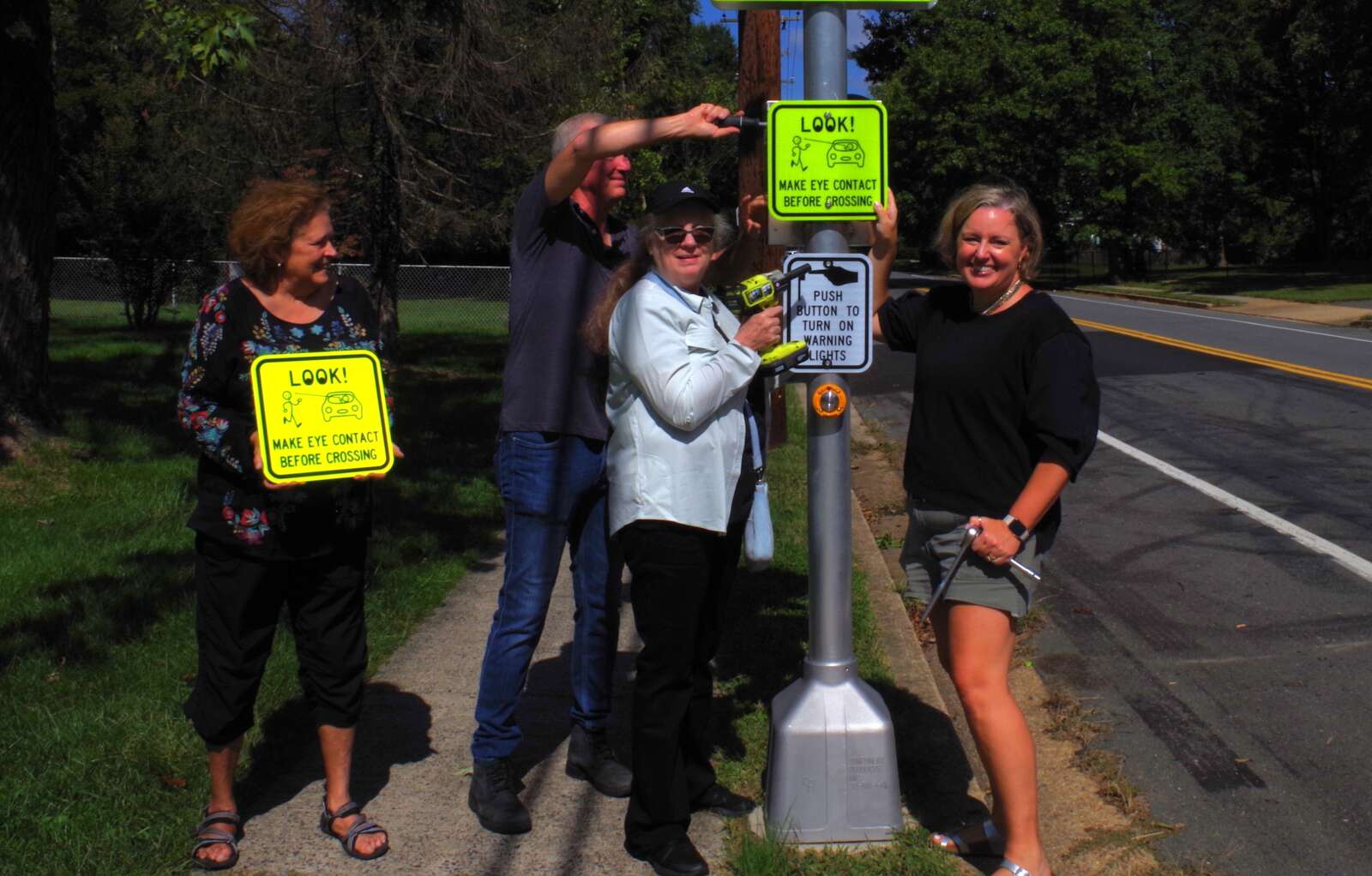
Some new traffic signs have popped up around Vienna, but unlike traditional stop or speed limit signs, these yellow, reflective placards are intended more for sidewalk users than road users.
Volunteers with the Vienna Pedestrian Advisory Committee (PAC) started posting the signs on pedestrian signal poles around town in late September for their “Eye to Eye” campaign, which encourages walkers to make eye contact with drivers before stepping into a crosswalk.
The campaign’s launch coincides with National Pedestrian Safety Month, which occurs every October. It also comes on the heels of a new Virginia law that requires drivers to fully stop, not just yield, when pedestrians are crossing.
However, PAC chair Angel Sorrell says “Eye to Eye” was in the works months before that legislative change took effect on July 1.
“What we found in the Town of Vienna is that, coming out of Covid, there’s just a lot more walking around town, which we love and we’d like to support that,” Sorrell said. “While that worked well when there weren’t a lot of cars on the road, as cars have increased, we’re seeing that pedestrians are crossing intersections and really not looking and making eye contact and crossing the intersections in a safe way.”
Pedestrian safety was a nationwide concern before the pandemic, but fatalities have noticeably jumped up since 2020, reaching a 41-year high of at least 7,508 deaths in 2022. In Fairfax County, 65 people were killed in traffic crashes last year — 32 of them pedestrians, the most since Virginia started regularly collecting data in 2010.
None of those deaths were in the Town of Vienna, and the national increase in pedestrian deaths has been attributed to a number of factors, including deadly road design and a trend toward large vehicles, beyond the capacity of a seven-person, all-volunteer committee to address.
But Sorrell says PAC had been “wrestling” with ways they could help keep pedestrians safe when committee member Brian Land suggested installing signs that encourage eye contact like ones he’d seen while on vacation in Nashville.

“We worked with the town and said that, as volunteers, we would post these signs in a temporary fashion at really high-traffic intersections, even some with the flashing signs,” Sorrell said. “We would install them around town in a temporary fashion through the fall. So, that’s what we’ve done.”
Fixed around eye level on poles with pedestrian crossing buttons, the signs feature two stick figures — one on foot and one seated in a car — with an arrow between their eyes to indicate that they’re looking at each other.
“LOOK! Make eye contact before crossing,” they say.
Sorrell says PAC purchased 38 signs and placed two to four at busy intersections, depending on how many each site could accommodate. The volunteers plan to leave the signs at their current locations through the fall before moving them to different intersections around town about once every quarter.
The “Eye to Eye” campaign joins a slew of efforts by Fairfax County to address the recent uptick in pedestrian fatalities, from crackdowns on aggressive driving by the police to funding for crosswalks, trail maintenance and other pedestrian and bicycle projects.
So far, the county has seen seven pedestrian fatalities, most recently on Richmond Highway this past Saturday (Oct. 7). At this time in 2022, there were 14 fatalities.
In addition to “Eye to Eye,” PAC has been working with town staff to identify and fill in sidewalk gaps, an effort that has quickened in pace over the past year. Around May, the committee also started an initiative to help residents maintain clean sidewalks and address overgrown bushes and tree limbs that might create an obstacle for pedestrians.
“We just needed to have more safety guardrails really put around our pedestrians and crosswalks,” Sorrell said. “[The General Assembly was] working at it from a legislative side to change that law that just went into effect. But we really wanted to arm pedestrians with the tools that they need to be successful in crosswalks.”
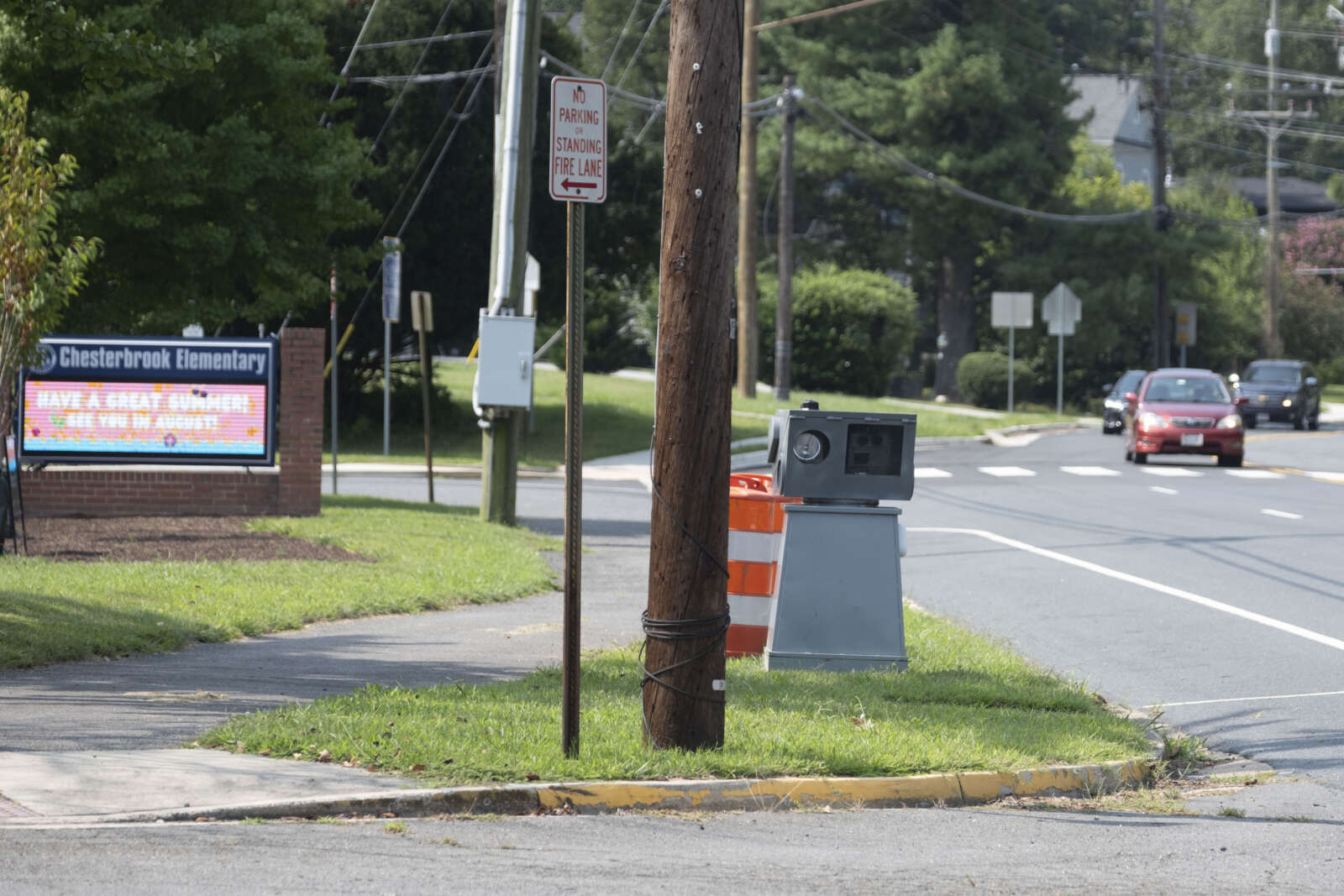
Some broken lights have unexpected challenges for Fairfax County’s speed camera pilot program, which appears to be having an effect on drivers, based on early data.
For about a week in mid-July, the Winko-Matics — flashing lights that signal when a school zone is in effect — failed to turn on at three of the eight sites involved in the pilot, according to the Fairfax County Police Department.
As a result, the cameras at Irving Middle School in West Springfield and London Towne Elementary School in Centreville stopped issuing citations, the police department announced on Aug. 16. The lights for both school zones ceased functioning correctly on July 17 to July 28.
In an Aug. 21 update, the department reported that the Winko-Matics on Franconia Road for Key Middle School in Springfield also encountered issues during that time frame.
“The cameras correctly issued citations during summer school operations, but the Winko-Matics did not function properly,” the FCPD said, stating that any citations issued while the lights were broken will be voided or reimbursed.
As of last Thursday (Aug. 24), the department’s vendor was still conducting a review to determine exactly when the lights weren’t working, so it’ll take some time to figure out how many citations were affected, FCPD public information officer Sgt. Jacob Pearce told FFXnow.
The westbound camera on Franconia Road remains offline after construction work on a private property accidentally severed an electrical connection, but the other cameras and Winko-Matics are now functioning properly, according to Pearce.
Despite those technical issues, speed surveys conducted before and during the pilot suggest the new cameras have been effective at slowing down drivers, according to FCPD Sgt. Ian Yost.
Average speeds decreased between last fall and this past May at all but one of the six evaluated sites — London Towne, Irving, Key, South County High School, and Chesterbrook Elementary School.
The only outlier was northbound Soapstone Drive near Terraset Elementary School in Reston, which saw a 3% uptick to 24.4 mph, but the average speed recorded before the pilot (23.8 mph) was already below Virginia’s 25-mph speed limit for school zones.
Prior to getting the photo speed cameras, the other schools were all seeing average speeds over 30 mph, led by nearly 37 mph on southbound Stone Road near London Towne. In May, speeds dropped to 24-28 mph, with South County seeing the biggest change at 37%.
“The speed cameras is just a piece of the puzzle, but it does help as our…data did show that it did have an effect in slowing down speeds of drivers in and around schools,” Yost said. “So, I do think it does fit with our overall idea and implementation of traffic safety here in Fairfax County.” Read More
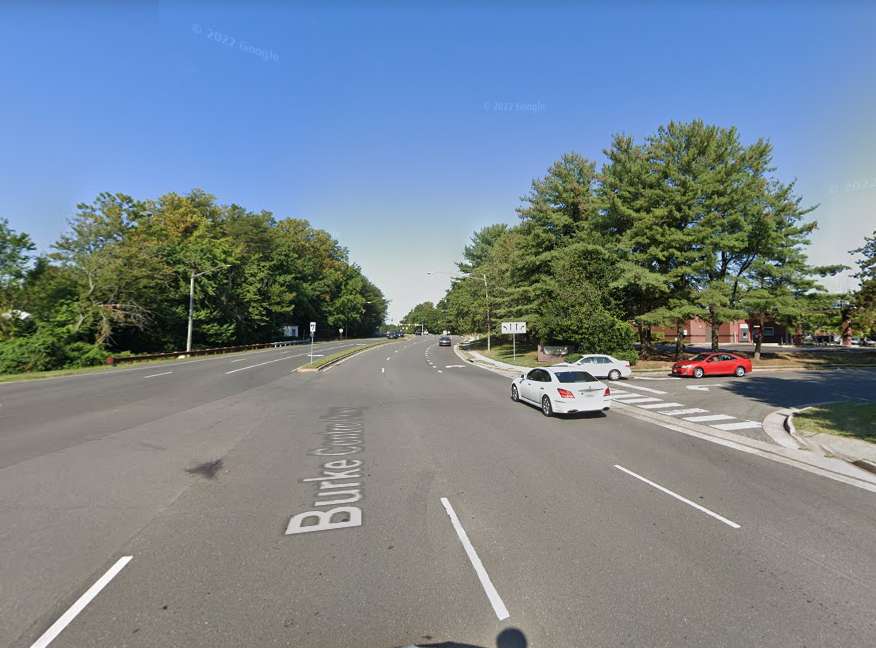
In October, the Virginia Department of Transportation will put together recommended improvements for the portion of Burke Centre Parkway where a fatal crash occurred last month.
The recommendations will come after VDOT staff can review the official police investigative report on the crash in September. The department is also planning to conduct studies on potential speed limit changes and the feasibility of a traffic signal in September and October.
The exact dates when the recommended improvements will be presented and implemented are to be determined, VDOT Assistant District Administrator Steven Welch said at a virtual community meeting about the parkway Tuesday night (August 15).
The timeline for implementation can depend on the nature of the changes. A median closure would take less time put in place than a new traffic signal, for example, Welch said.
“The range is really wide,” he said.
Welch also recapped safety improvements made on Burke Centre Parkway in the last three years, which include removing the flashing yellow arrow from 3:30 to 5:30 p.m. at the intersection of Burke Centre Parkway and Roberts Parkway and adding pedestrian warning signs at four crosswalks.
More than 70 people attended the virtual community meeting, which Braddock District Supervisor James Walkinshaw hosted in the wake of the July 18 crash that killed 17-year-old Rebekah Zarco and hospitalized three other teens.
The bulk of the roughly hour-long meeting featured questions and comments from community members, including on the possibility that the July crash involved cars racing.
“In the days after the crash, we did hear there may have been vehicles racing,” said Second Lt. Ian Yost, a crash reconstruction unit supervisor in the Fairfax County Police Department’s traffic division.
Police say 42-year-old Burke resident Jose Angel Zelaya, who was arrested on Aug. 1 and has been charged with involuntary manslaughter, was driving at almost double the 40-mph speed limit when he crashed into the car of teens.
District 37 State Sen. David Marsden said he was intrigued by the potential connection to racing. He said he has submitted a bill to the General Assembly to deal with loud vehicle muffler noise.
“Certainly loud mufflers don’t cause people to race, but it certainly is indicative of some desire to be aggressive with your car, at least its noise and perhaps its speed,” Marsden said.
Some community members asked about the possibility of adding speed cameras. Under a 2020 state law, Fairfax County can place speed cameras in school and construction zones. A pilot program with cameras outside eight schools has been underway since February.
“Where we are right now is we recently started the school zone pilot program,” Walkinshaw said. “I anticipate we’ll want to expand that to other schools around the county and use that to learn and maybe advocate for additional authorities from the General Assembly in Richmond to do more.”
Multiple community members also brought up the possibility of adding a median barrier at the intersection outside the Burke Centre Shopping Center where the crash occurred.
At the meeting, FCPD officers also provided a brief overview of the department’s recent traffic safety efforts, including the summer “Road Shark” campaign and recent traffic enforcement on Burke Centre Parkway.
FCPD’s motor unit issued 440 citations while conducting “high visibility enforcement” on the roadway between July 24 and July 29, according to a presentation at the meeting.
Community members who have questions or comments about Burke Centre Parkway can contact Walkinshaw’s office at braddock@fairfaxcounty.gov or 703-425-9300. The FCPD says anyone who may have witnessed something related to the July 18 crash can contact its crash tip line at 703-280-0543.
Image via Google Maps
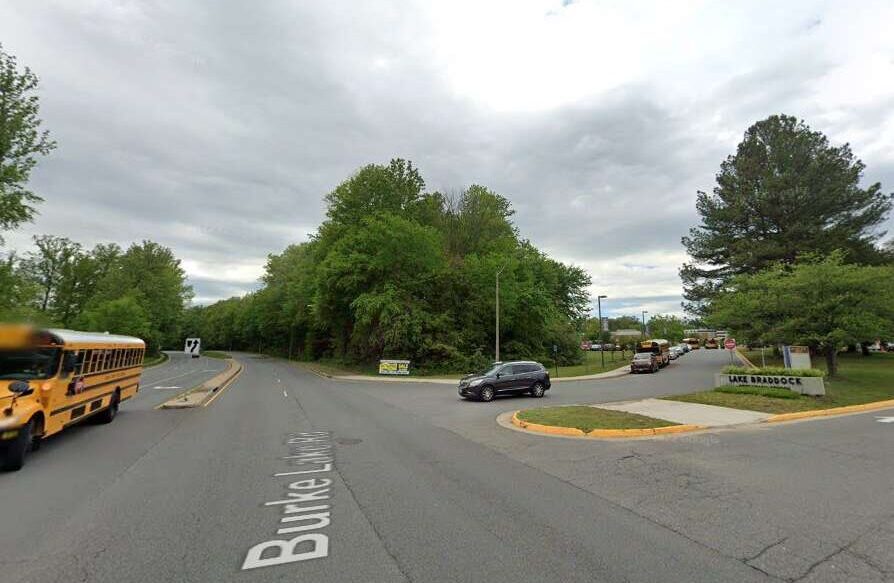
Fairfax County is making another push to fund pedestrian safety improvements at Shrevewood Elementary School in Idylwood.
The long-gestating crosswalks project is one of five that the Fairfax County Department of Transportation intends to submit to the state for funding consideration under the federal Transportation Alternatives grant program.
“This program invests in community-based projects that expand non-motorized travel choices and enhance the transportation experience by improving the cultural, historical and environmental aspect of the transportation infrastructure,” FCDOT said in a press release last week.
For fiscal year 2025, which starts July 1, 2024, the department will request a total of $9.2 million to fill walkway gaps to the Mason Neck Trail in Lorton, add a shared-use path on Compton Road in Centreville, and support three Safe Routes to Schools projects — a program that encourages students to walk and bike to school.
Shrevewood Elementary School — Safe Routes to School
- Total estimated cost: $2.99 million
- Grant request: $1.14 million
Part of a larger effort to improve safety in the Shreve Road corridor after a fatal crash in 2019, this project will add marked crosswalks at Fairwood Lane, the school’s eastern driveway and across Virginia Lane at Virginia Avenue. The Fairwood Lane crosswalk will include a pedestrian refuge island.
FCDOT says the crosswalks “will provide neighborhood access to school amenities” and the nearby Washington & Old Dominion Trail.
Bush Hill Elementary School — Safe Routes to School
- Total estimated cost: $3.66 million
- Grant request: $1.86 million
Approximately 850 feet of sidewalk will be added on Bush Hill Drive between Ninian Avenue and Larno Avenue in Rose Hill.
“Completing this missing sidewalk link will improve safety and accessibility for children walking and bicycling to school,” FCDOT said.
Lake Braddock Secondary School — Safe Routes to School
- Total estimated cost: $2.55 million
- Grant request: $2.04 million
Crosswalks and a pedestrian signal will be constructed at the school’s entrance on Burke Lake Road. The project will also reconstruct a sidewalk on the road’s south side to be 6 feet wide and bring six ramps up to ADA standards.
Mason Neck Trail
- Total estimated cost: $13.96 million
- Grant request: $1.7 million
The project will build missing pieces of the walkway along Gunston Road from Richmond Highway (Route 1) to the existing trail.
Compton Road Walkway
- Total estimated cost: $9.3 million
- Grant request: $2.5 million
Approximately 550 feet of a 10-foot-wide, paved shared use path will be added on the east side of Compton Road, connecting the Cub Run Stream Valley Trail with an existing path crossing to the Bull Run Regional Events Center’s entrance.
The project will also widen a bridge over Cub Run to accommodate the shared use path.
FCDOT Communications Specialist Lynn Krolowitz noted that the grant request amounts could be revised if the project cost estimates changed before the applications are finalized in October.
“FCDOT select projects based on several factors such as program eligibility criteria and project readiness requirements, the need of continued funding for existing projects, and previous Board approval/consideration, which assumes some level of public involvement,” Krolowitz said in an email to FFXnow.
To be eligible for Transportation Alternatives grants, projects must have already gotten public feedback, be ready for design, require less than four years of construction, have a “logical” endpoint — such as an existing sidewalk or a road intersection — and be beneficial even if no other improvements are made in the area, according to FCDOT.
Three of the projects under consideration in this round, including the Shrevewood project, have previously gotten the grants, giving them priority in the selection process, Krolowtiz says.
FCDOT will host a virtual public input meeting to discuss the proposed projects at 6 p.m. tomorrow (Wednesday).
Image via Google Maps

